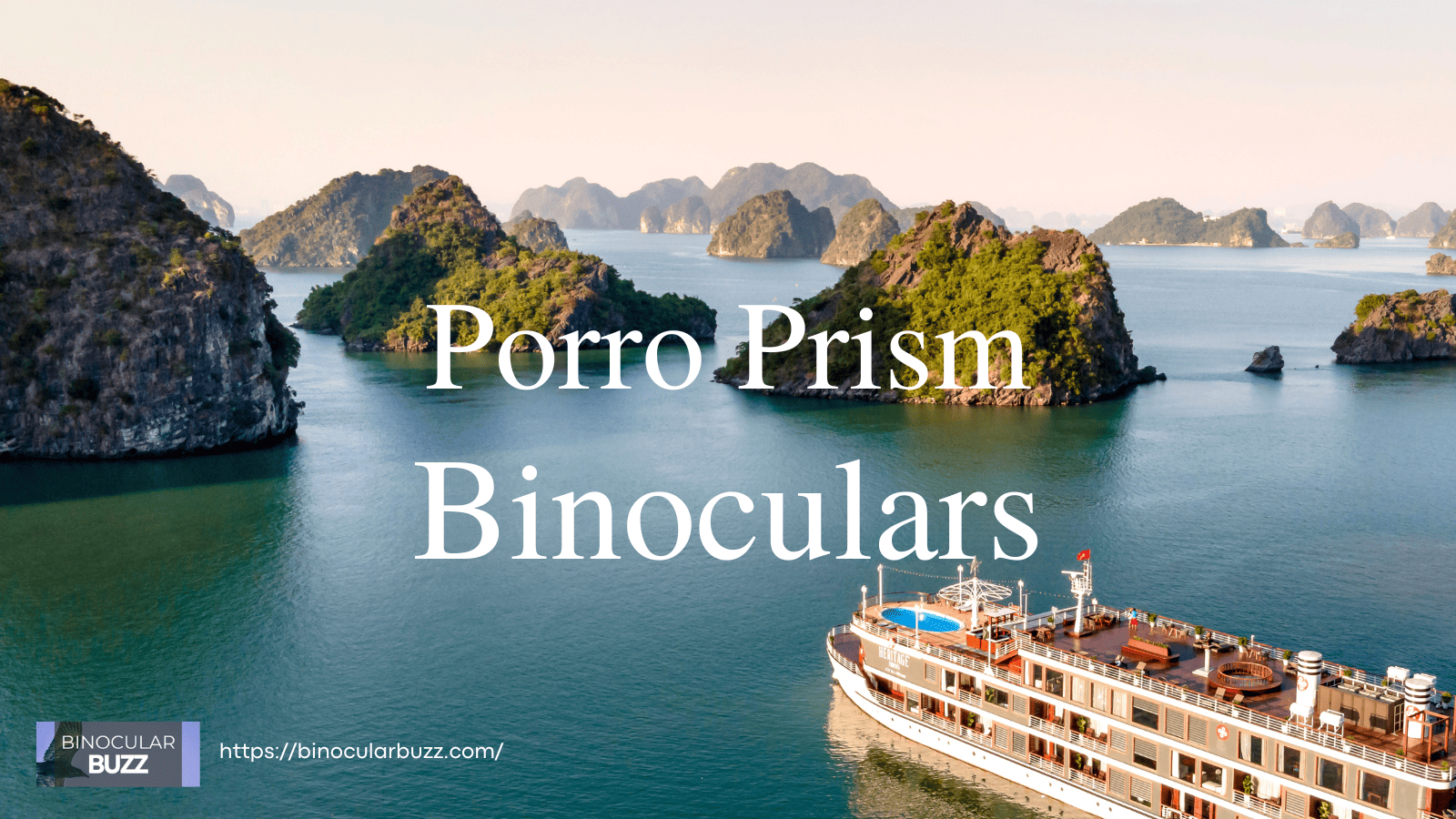Porro Prism Binoculars: A Practical Guide [2024]
Prisms are used in binoculars to turn the magnified image right side up. Without the use of prisms, your binocular view would be upside down. The two main types of prism configuration used in binoculars are roof prisms and porro prisms.
The basic difference between porro prism binoculars and roof prism binoculars is the way the prisms are arranged within the binocular body. Porro prism binoculars have objective lens tubes that are offset from the eyepieces, while roof prism binoculars have two straight tubes, making them sleeker.
This site participates in the Amazon Services LLC Associates Program designed to give sites like ours a way to earn advertising fees by linking to products on Amazon.com at no additional cost to you. I appreciate your support. Thank you!
Top Picks for Porro Prism Binoculars
Why Do Binoculars Have Prisms?
The optical system of a binocular uses a combination of lenses and prisms. Binoculars have lenses to magnify the image. On the other hand, binoculars have prisms for:
- Image orientation: The lenses in binoculars actually flip the image upside down and backwards! Prisms, like magic mirrors, bend and reflect the light path to correct the orientation, delivering a right-side-up view to your eyes.
- Compactness: Without prisms, binoculars would be much longer and bulkier. Prisms fold the light path within the binoculars, allowing them to be smaller and more portable. This is especially important for high-magnification binoculars, which would otherwise be unwieldy.
There are two main types of prisms used in binoculars:
Roof Prism Binoculars
Roof prisms, as the name suggests, have a roof-like shape inside the binoculars. This design folds the light path more tightly, making the binocular more compact and lightweight, ideal for outdoor activities that require portability.
The optical path in roof prism binoculars is straight, resulting in a sleek and streamlined shape. However, the eyepieces may be closer together, which can be less comfortable for some users.
Porro Prism Binoculars
Porro prism binoculars have an offset design that resembles a zigzag pattern. This design allows for a longer optical path, which contributes to better depth perception and image quality.
Porro prism binoculars are known for their wider field of view and typically offer a more immersive viewing experience. Porro prisms create a wider separation between the eyepieces, making them more comfortable to hold. However, they also make the binoculars larger.
Schematic

The above schematic, courtesy CELESTRON, shows how light travels within the binocular tubes in each case. Below is a real life example of the two types. Celestron – Nature DX 8×42 is a Roof Prism Binocular while Celestron – Ultima 8×42 is a Porro Prism Binocular
Are Porro Prism Binoculars Better Than Roof Prism Binoculars?
I hate my answer, but it does happen to be the truth. There’s no definitive answer as it really depends on various factors like intended use, budget, portability preference, etc. In fact, both Porro and Roof prisms have their pros and cons, making the choice depend on your needs and preferences.
Here’s a quick breakdown:
Porro Prism Binoculars:
- Pros: Brighter views due to higher light transmission, often more comfortable eye spacing, generally cheaper at lower price points.
- Cons: Bulkier and heavier, can be more susceptible to alignment issues.
Roof Prism Binoculars:
- Pros: Compact and lightweight, sleeker design, often more robust and weatherproof.
- Cons: Generally less bright than Porros, can be more expensive, some users find the closer eye spacing less comfortable.
So, if you prioritize bright views and affordability, Porros might be your match. But if you value portability, durability, and a sleek design, roof prisms could be the way to go. Ultimately, the “better” choice depends on your specific needs and what features matter most to you.
It is a good idea to try out both types of binoculars to get a real feel, if possible.
Advantages of Porro Prism Binoculars
In this section of the blog I shall explain the advantages of porro prism binoculars in some detail. These unique binoculars offer several benefits that make them a popular choice among outdoor enthusiasts and nature lovers.
Enhanced Depth Perception
One of the standout features of porro prism binoculars is their ability to provide enhanced depth perception. The offset prism design allows for a wider separation between the objective lenses, resulting in a more three-dimensional image.
This is particularly useful when observing wildlife or surveying landscapes, as it allows for a more immersive and realistic viewing experience.
Superior Light Transmission
One of the main advantages of porro prism binoculars is their superior light transmission compared to other types of binoculars. This is due to the design of the prism system, which allows for minimal light loss.
As a result, porro prism binoculars offer brighter and clearer images, even in low-light conditions. In practical terms, this means that when you’re out birdwatching early in the morning or observing wildlife at dusk, porro prism binoculars will provide you with a better view.
You’ll be able to see details more clearly and enjoy a more immersive experience.
Superior Image Quality
Due to the longer optical path, porro prism binoculars often provide superior image quality compared to their roof prism counterparts. The offset prism design minimizes light loss and reduces internal reflections, resulting in sharper and brighter images.
This is particularly noticeable in low-light conditions, where porro prism binoculars excel in delivering clear and detailed views.
Wider Field of View
Porro prism binoculars typically offer a wider field of view compared to roof prism binoculars. This means that you can see a larger area without having to constantly move your binoculars.
Whether you are birdwatching or attending a sporting event, a wider field of view allows you to capture more of the action and enjoy a broader perspective.
It’s especially beneficial when you’re trying to track fast-moving objects, such as birds in flight or wildlife on the move.
Cost-Effective Option
Porro prism binoculars are generally more affordable compared to roof prism binoculars of similar quality.
The simpler prism design and manufacturing process contribute to their cost-effectiveness, making them a great option for beginners or those on a budget without compromising on performance.
Key Advantages of Porro Prism Binoculars:
- Superior light transmission for brighter and clearer images, even in low-light conditions.
- Wider field of view allows for easier tracking of fast-moving objects.
- Budget friendly pricing makes it affordable to beginners.
Buying Porro Prism Binoculars: What to Look For
Porro prism binoculars are a popular choice due to their excellent optical performance and affordability. However, with a wide range of options available in the market, it can be overwhelming to select the right one for your needs.
In this article, I will list out and explain the important factors that you must look for, when purchasing porro prism binoculars. I also provide tips on choosing the right binoculars for specific activities such as birdwatching or stargazing.
1. Binocular Magnification
Binocular Magnification is, of course, the most important spec to look for. It is denoted by a number followed by an “x” (e.g., 8x, 10x). Here are some key points to consider:
- Higher magnification allows for a more detailed view of distant objects, but it also reduces the field of view and makes the image shakier.
- For general-purpose use, 8x or 10x magnification is sufficient. These options strike a good balance between magnification, field of view and image stability.
- Professionals and researchers may require a higher magnification such as 12x or 15x. However, you must ensure that you either buy an image stabilizing binocular or you can stabilize the image using a tripod or other support.
2. Objective Lens Diameter
The objective lens diameter is the second number in the binocular’s specification (e.g., 8×42, 10×50). It determines how much light enters the binoculars, which impacts brightness and low-light performance.
Consider the following:
- A larger objective lens diameter allows more light to enter the binoculars, resulting in brighter images, especially in low-light conditions.
- However, larger objective lenses also make the binoculars heavier and bulkier, which may not be ideal for extended use or portability.
- For general-purpose use, a 30mm to 42mm objective lens diameter is a good compromise between brightness and portability. For astronomy, low-light conditions you may opt for 50mm or even larger objective lenses. Be aware that the binocular will be fairly heavy.
3. Eye Relief
Eye relief refers to the distance between the eyepiece and your eye when you view the entire field of view. It is an important consideration, especially for eyeglass wearers.
Keep these points in mind:
- Longer eye relief allows you to keep your glasses on while using the binoculars, ensuring a comfortable viewing experience.
- Typically, an eye relief of 14-15mm is suitable for most users, including those who wear glasses. However, if you have thick eyeglass lenses, you may need a higher eye relief.
- Some binoculars offer adjustable eyecups that can be twisted up or down to optimize eye relief. This feature is beneficial for both eyeglass and non-eyeglass wearers.
Choosing Binoculars for Specific Activities
Different activities require specific features from binoculars to enhance the viewing experience.
Here are some tips for choosing binoculars for specific activities:
- Birdwatching: It is better to go for binoculars with a wider field of view (e.g., 8×42) to track fast-moving birds easily. Consider models with close focus capabilities if you plan to observe birds at a close range.
- Stargazing: Look for binoculars with higher magnification (e.g., 10×50) to observe celestial objects with more detail. Models with good low-light performance are essential for stargazing.
- Sporting Events: Choose binoculars with a wide field of view, enabling you to follow the action without constantly adjusting the binoculars. Compact and lightweight options are preferable for easier portability.
- Outdoor Adventures: Consider rugged and waterproof binoculars that can withstand harsh conditions. Look for models with rubber armor for a secure grip and extra protection.
Porro Prism Binoculars: Care & Maintenance Tips
Porro prism binoculars are a popular choice among outdoor enthusiasts and nature lovers for their excellent image quality and wide field of view.
Some Tender Love & Care (TLC) will ensure that your binoculars continue to deliver optimal performance for a long time. In this section of the article, I share some useful tips and techniques to help you keep your porro prism binoculars in top shape for years to come.
1. Cleaning Techniques
Keeping your binoculars clean is the first step in getting the best performance and longevity from them. Here are some recommended cleaning techniques:
- Start by using a soft brush or air blower to remove any loose particles or debris from the lenses and the body of the binoculars.
- Use a microfiber cloth or lens cleaning tissue to gently wipe the lenses in a circular motion, starting from the center and moving towards the edges.
- For stubborn smudges or fingerprints, dampen the cloth or tissue with lens cleaning solution or lens cleaning fluid specifically designed for optical surfaces. Apply the solution sparingly and avoid getting it on other parts of the binoculars.
- Never use harsh chemicals, solvents, or household cleaners as they can damage the lens coatings or other parts of the binoculars.
- Remember to also clean the eyepieces and the diopter adjustment ring, if applicable, using the same gentle cleaning techniques.
2. Storage Tips
Proper storage will protect your binoculars from damage and maintain their performance. Consider the following tips:
- When not in use, store your binoculars in a protective case or a padded bag to shield them from dust, moisture, and accidental impacts.
- Avoid storing them in extreme temperatures or in direct sunlight, as this can cause damage to the lens coatings and other components.
- If your binoculars are equipped with a strap, make sure to securely attach them to prevent accidental drops or falls.
3. Protection from Damage
Taking a few precautions can help protect your binoculars from potential damage. Here are some tips:
- Invest in a lens cap or lens cover to protect the objective lenses from scratches and dust when not in use.
- Use a neck strap or harness to distribute the weight of the binoculars and reduce the risk of dropping them.
- Avoid placing your binoculars on rough or abrasive surfaces that could scratch the body or the lenses.
- If you’re going on a particularly rugged adventure, consider using a binoculars harness system that keeps the binoculars close to your body and provides additional protection.
4. Troubleshooting Common Issues
Even with proper care, occasional issues may arise with your porro prism binoculars.
Here are some common problems and troubleshooting techniques:
- Double vision: If you experience double vision, it may be due to misaligned prisms. To fix this, simply adjust the interpupillary distance by sliding the barrels closer together or farther apart until you achieve a single, merged image.
- Foggy or hazy view: If your binoculars become foggy or hazy, it could be a sign of moisture inside. In such cases, remove the binoculars from the case or bag and allow them to air dry in a well-ventilated area. Avoid using heat sources or direct sunlight to speed up the drying process.
- Loose or stiff focus wheel: If the focus wheel becomes loose or stiff, it may need to be adjusted. Refer to the manufacturer’s instructions on how to tighten or loosen the focus wheel tension, or contact their customer support for further assistance.
Concluding Thoughts on Porro Prism Binoculars
Porro prism binoculars are a fantastic option for those who value high image quality, a broad field of view, and comfortable handling.
When selecting porro prism binoculars, it’s important to take into account factors like magnification power, objective lens diameter, and eye relief. Give your porro prism binoculars a lot of TLC so that your binoculars last longer and perform at their best.












